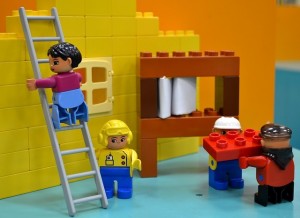 Have you ever put together a jigsaw puzzle? It can be a rewarding pastime, but it requires patience. The pretty picture on the cover of the box suddenly seems a lot more daunting when the pieces are dumped out in an incoherent heap. Having a strategy at this point can make or break the puzzle experience. Puzzlewarehouse.com offers some strategic tips for putting together jigsaw puzzles. These strategic tips overlap with what collaborative divorce attorneys do, as putting together a divorce agreement is not unlike putting together a puzzle. Here are six pieces of advice from puzzlewarehouse.com, with related insights into the collaborative divorce process:
Have you ever put together a jigsaw puzzle? It can be a rewarding pastime, but it requires patience. The pretty picture on the cover of the box suddenly seems a lot more daunting when the pieces are dumped out in an incoherent heap. Having a strategy at this point can make or break the puzzle experience. Puzzlewarehouse.com offers some strategic tips for putting together jigsaw puzzles. These strategic tips overlap with what collaborative divorce attorneys do, as putting together a divorce agreement is not unlike putting together a puzzle. Here are six pieces of advice from puzzlewarehouse.com, with related insights into the collaborative divorce process:
- “Flip all pieces upwards.”
- “Having all your pieces facing the same way can be tedious, but it makes it so you’re working with the whole puzzle the whole time, and it’ll make the next steps quicker.”
What is true for puzzles in this first step is certainly true for divorcing couples. When couples begin the divorce process, they need to bring all their information (the “pieces”) to the table. To “flip a piece upwards”, whether it is an emotional concern or financial detail, is to bring it to the attention of everyone involved so it can be a part of putting the bigger picture together.
- “Find all the edge pieces.”
- “Constructing your border gives you a defined space that you’ll work inside as you build.”
During the first meeting between the clients and their chosen attorneys and any other professionals, parameters for the collaborative process are determined. This includes expectations of conduct and a participation agreement, as well as identifying the goals and interests of each client. This step sets the clear boundaries that are necessary for collaboration to work for the clients.
- “Sort by color.”
- “From here you can build recognized sections of the puzzle.”
Once clients gather the information regarding their lives and assets, attorneys help the clients identify different options for the agreement. If the pieces are sorted neatly and no information is missing, it is easier to fit everything together, from spousal maintenance and child support to real estate and personal property, so the big picture that’s formed is agreeable to both parties.
- “Special pieces.”
- “Some pieces will be part of really distinguishing parts of the puzzle because it has text on it, or a color that’s only in one spot. Keep those separate and build on them as you can… it will be easy to spot where it goes as you start assembling the puzzle.”
Each collaborative divorce is unique, and each couple has a different set of goals and circumstances they bring to the divorce process. Some issues take priority over others and must be addressed and put together before the other pieces can be finalized. Examples of special pieces in a divorce may be an out-of-state job offer, special needs children, or a family business.
- “Work on small sections at a time.”
- “Instead of trying to work on the entire puzzle at once, it can be really helpful to work on small portions so that you’re accomplishing sections. This will help keep you motivated and you’ll have a visual record of your progress.”
We help clients break the process down into manageable pieces, yet maintain perspective from 10,000 feet. It is easy to get lost “in the weeds” and get overwhelmed, so checklists and journals often work well for clients.
- “Don’t give up.”
- “When you’re tired… take a break… sometimes too much time at one problem can take away from [the puzzle process]. A fresh look at it later may help you see things you missed, too!”
Divorce is a project and often very stressful, but a collaborative team tries to pace the work so all parties are as comfortable as possible. Open communication is encouraged at all times, so needs are heard instead of missed. Taking an easier pace at times helps avoids burnout that often happens with litigated divorce cases.
* * *
It makes sense that people who have put a lot of jigsaw puzzles together would be more efficient when starting any puzzle than someone who has never put together a puzzle. In this way, collaborative divorce attorneys and professionals have developed their skills through practice and love to efficiently lead their clients towards the best agreement for everyone.
– Audra A. Holbeck
Put the (Divorce) Puzzle Together April 22nd, 2016Audra Holbeck
 “Mom, why won’t this piece fit here like it should?” My son is trying to build a dragon Lego kit, and, eager to get to the end, missed a couple steps in the instructions. He keeps fitting the pieces together, but isn’t getting any closer to completing the dragon. I tell him he needs to go back a few steps and figure out where the pieces aren’t put together correctly. Interestingly, the pieces he missed are small and seem inconsequential; however, as he soon discovers, they allow the dragon’s wings to unfold. Without those tiny pieces, the dramatic dragon simply could not be.
“Mom, why won’t this piece fit here like it should?” My son is trying to build a dragon Lego kit, and, eager to get to the end, missed a couple steps in the instructions. He keeps fitting the pieces together, but isn’t getting any closer to completing the dragon. I tell him he needs to go back a few steps and figure out where the pieces aren’t put together correctly. Interestingly, the pieces he missed are small and seem inconsequential; however, as he soon discovers, they allow the dragon’s wings to unfold. Without those tiny pieces, the dramatic dragon simply could not be.


